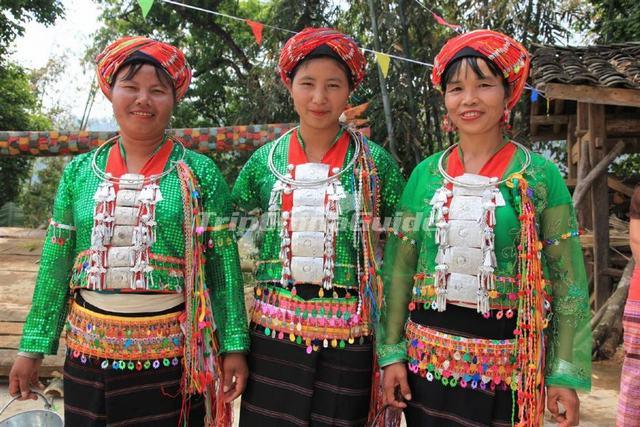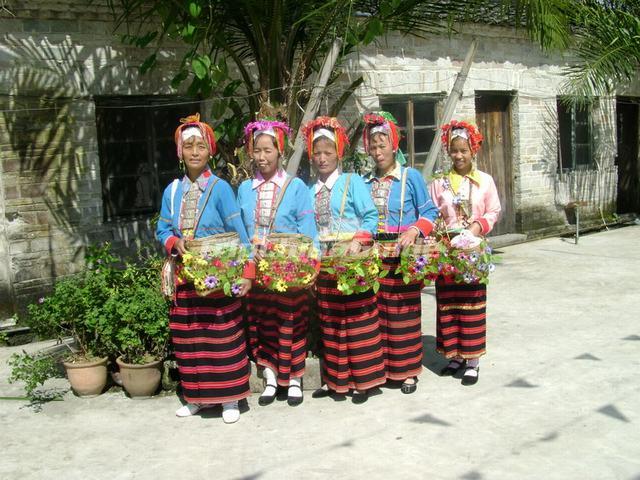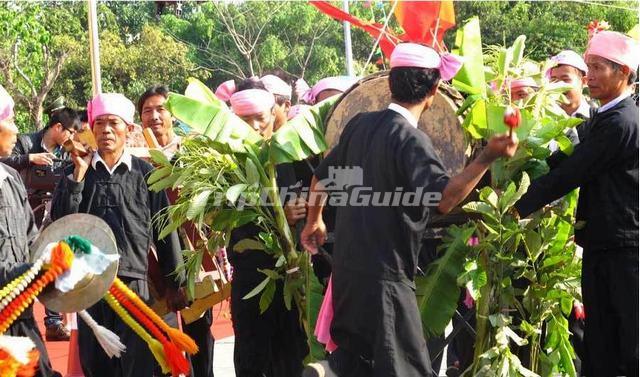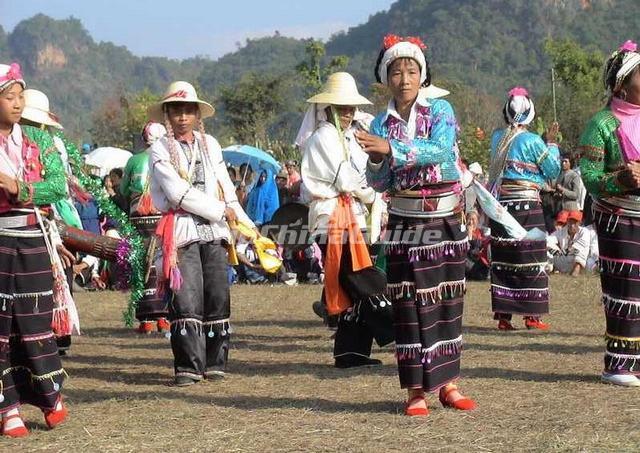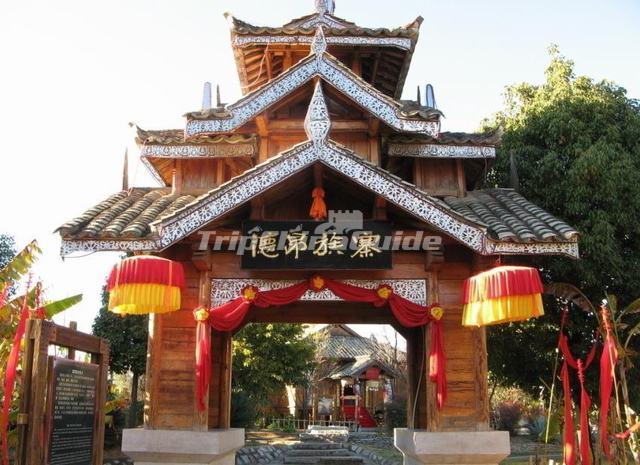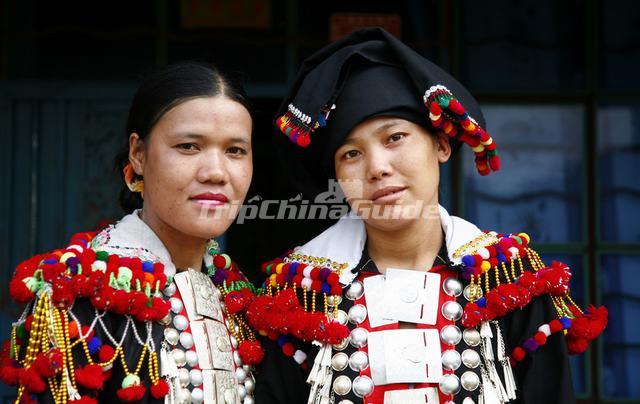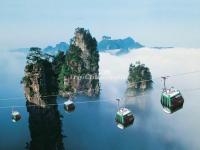De'ang Ethnic Group
The De'ang people are one of the ancient nationalities and one of the unique ethnic minorities in China. De'ang people mainly engaged in agricultural production.
Population
20,556 (2010)
Main Areas Inhabited by De'ang
The people of De'ang ethnic group are quite widely distributed over Yunnan Province. Most of them dwell in Santai Township in Luxi County of the Dehong Dai-Jingpo Autonomous Prefecture and in Junnong Township in Zhenkang County of the Lincang Prefecture. The others live scattered in Yingjiang, Ruili, Longchuan, Baoshan, Lianghe and Gengma counties. Some De'ang people live together with the Jingpo, Han, Lisu and Va nationalities in the mountainous areas. And a small number of them have their homes in villages on flatland peopled by the Dais.
Language
The De'ang language belongs to the South Asian family of languages. The De'ang people have no written script of their own, and many of them have learned to speak the Dai, Han or Jingpo languages, and some can read and write in the Dai language. An increasing number of them have picked up the Han language in years after the mid-20th century.
Climate and Resources
In the mountainous areas of Gaoligong and Nushan ranges in western Yunnan Province, the De'ang people have been living there for generations. The climate here is subtropical, and there is fertile soil, abundant rainfall, rich mineral resources and dense forests. The dragon bamboo here grows very long and has a stem with a diameter of 10 cm to 13 cm. The Zhenkang area has been famed for this kind of bamboo for the past 2,000 years. It is used to build houses and make household utensils and farm implements. Bamboo shoots are a famed delicacy.
The De'angs, who took to farming since very ancient times, grow both wet and upland rice, corn, buckwheat and tuber crops as well as walnut and jute. And they have learned to cultivate tea, cotton, coffee, and rubber after the founding of the People's Republic in 1949.
The De'angs have been great tea drinkers since very early times, and now every family has tea bushes growing among vegetables, banana, mango, jack fruit, papaya, pear and pomegranate trees in a garden around the house.
History
De'ang was a name given to this ethnic group in the Qing Dynasty (1644-1911). Before that time the De'angs along with the Blang and Va ethnic minorities speaking a south Asian language inside Yunnan Province were called "Pu people," according to historical records. In those bygone times the "Pu people" were distributed mainly in the southwestern part of Yunnan Province, which was called Yongchang Prefecture in the Han Dynasty (206 B.C.-A.D. 220). Their forefathers settled on the banks of the Nujiang River (upper reaches of the Salween that flows across Burma) long before the arrival of the Achang and Jingpo ethnic minorities.
Development of De'ang society has been uneven. Since the De'angs have lived in widely scattered localities together with the Han, Dai, Jingpo, Va and other nationalities, who are at different stages of development, they have been influenced by these ethnic groups politically, economically and culturally. Dai influence is particularly strong since the De'angs had for a long period lived in servitude under Dai headmen in feudal times. However, some traces of the ancient clan and village commune of the De'ang ethnic minority are still to be found in the Zhenkang area.
The production unit of the De'ang ethnic group is the family, and there is marked division of labor according to sex and age. The farm tools used are bought from Han and Dai regions. Generally speaking, the De'ang people practice intensive farming on flatland and on farms near the Han and Dai regions or in paddy fields. Dry land is not cultivated meticulously.
In De'ang villages in the Dehong area, the cultivated land used to be communally owned. The wasteland around each village was also communally owned, but people could freely open up the land for cultivating crops. If the land was left uncultivated, it automatically reverted to communal ownership again. In later times, the selling or mortgaging of paddy fields and gardens led to the emergence of private ownership. As a result, most of the paddy fields came into the possession of Han landlords, rich peasants and Dai headmen.
Without either draught animals or funds, and burdened down with taxes and debts, the De'angs could not open up hillside land and gradually became the tenants or farmhands of the landlords, rich peasants and headmen. Many cut firewood, burned charcoal and wove in the off-hours to make ends meet.
In the Zhenkang Prefecture, which had plenty of dry land and little paddy land, private ownership of land and usury had been uncommon. Yet feudal ownership and tenancy show such traces of communal ownership of land as strict demarcation lines between the land of different villages and clearly-marked signs between communally owned land, woods and small privately owned plots. Communal land in each village was managed by headmen. And anyone, from other villages who wanted to rent the communal or private plots, had to get the permission of village headmen.
Some De'ang people still retain some traces of the communal system in the way they live. A clan commune was formed by many small families with blood relations. Usually thirty to forty people shared one outsized communal house, but each individual family had its own fireplace and kept its own account. Primitive distribution on an equal basis was practiced in farming. But exploitation had appeared with some families owning more cows and working less.
The De'ang people everywhere used to live under the sway of the feudal lords of the Dai ethnic group. De'ang headmen in the Dehong region were either appointed by Dai chieftains or were hereditary. To control and exploit the De'ang people, Dai chieftains granted official titles to De'ang headmen and let them run the villages, impose levies, and collect tributes. Some De'ang people who lived in or near areas under the Jingpo's jurisdiction had to pay "head taxes." This constituted another burden for the De'ang people who were bled white by heavy taxes and rents collected by Dai chiefs or the Kuomintang government.
Landlords and rich peasants of the De'ang ethnic group made up only two per cent of the population. Many of them were appointed headmen of Dai chiefs. Being tenants or farmhands of either Han landlords and rich peasants or Dai headmen, most De'angs lived in dire poverty.Post-1949 Development
A new day dawned for the De'ang people when Yunnan Province was liberated in 1951. The first thing the De'angs did was to restore social order and develop farm production after helping the government round up remnant KMT troops who had turned bandits. In 1955 land was distributed to the De'ang people who made up half of the population on the flatland and in the semi-hilly areas of Zhenkang, Gengma, Baoshan and Dehong in an agrarian reform in which both the De'ang and Dai people participated. Not long afterwards, the De'angs set up agricultural cooperatives. At the same time, the rest of the De'ang people living in the mountainous areas of Dehong, like the Jingpos dwelling there, formed mutual aid groups to till the land, carried out democratic reforms and gradually embarked on the socialist road.
The De'ang people, who lived in compact communities in Santaishan in Luxi County and Junnong in Zhenkang County, established two ethnic township governments. In July 1953, the Dehong Dai-Jingpo Autonomous Prefecture was established, and the De'angs had 12 representatives in the government. Many functionaries of the De'ang people are now serving in government offices at various levels. Some De'ang people in Yunnan Province have been elected deputies to local people's congresses and the National People's Congress.
The economy in the De'ang areas has been developing apace. Take Santaishan in Luxi County for example. People here started farmland construction on a big scale with their Han and Jingpo neighbors in the wake of agricultural cooperation. Today, the land here is studded with reservoirs and crisscrossed by canals, and hill slopes have been transformed into terraced plots. Tea and fruit are grown, and large numbers of goats, cows and hogs are raised. The cropped area has increased enormously, and grain production is four times the 1951 level.
As the people of this minority group could scarcely make enough to keep body and soul together, no De'angs went to school in pre-liberation days. Those who could read some Dai words in those days were a few Buddhist monks. Pestilence and diseases due to poor living conditions were rampant, and there were no doctors. People had but to ask "gods" to cure them when falling sick.
Today De'ang children can attend primary schools established in villages where the De'angs live. Priority is given to enrolling De'ang children in other local schools. Large numbers of illiterate adults have learned to read and write, and the De'ang people now have even their own college students, teachers and doctors.
Smallpox which had a very high incidence in localities peopled by the De'ang people has been eradicated with the assistance of medical teams dispatched by the government. Malaria, diarrhea and other tropical diseases have been put under control.
Building
Like most people in the sub-tropical regions, the De'ang people live in houses made of bamboo. While some dwell in large communal houses, those in the Dehong area have a two-story house to every family. The upper floor serves as living quarters, kitchen and storeroom, and beneath it is a stable for animals and poultry. There are also outhouses in which are stored firewood and foot-pedaled mortars used in husking rice.
Clothing
People dress in traditional costumes studded with silver ornaments. Men wear turbans. Boys look handsome with their silver necklaces. Most women wear dark dresses lined with extra large silver buttons at the front, and skirts with red and black flower patterns. Rattan waistbands and silver earrings add grace and harm. Nowadays, De'ang boys have the same hairstyle as the Hans and do not like to burden their bodies with heavy ornaments. Men have the custom of tattooing their bodies with designs of tiger, deer, bird and flower.
Marriage
Monogamy is practiced. People of the same clan do not marry with one another. Intermarriage is rare with people of other ethnic groups. Young people have the freedom to choose their own partners, and courtship lasts for a long time. When a girl hears a love song under her window, she either ignores it or responds. If she likes the boy singer, she tosses a small blanket down to him. Then she opens the door and lets him in. The boy covers his face with the blanket, enters her room, and meets the girl by the side of the fire. The parents are happy and do not interfere.
The lovers often meet and chat until midnight or dawn. After a few dates, the boy gives her a necklace or waistband as a token of his love. The more waistbands a girl gets, the more honored she is. To show his devotion, the boy wears earrings. The number she gives him is a mark of her love.
If the courtship goes well, the boy would offer gifts to the girl's family and send people to propose marriage. Even if the girl's parents disagree, the girl can decide for herself and go to live in the boy's house.
Marriage Customs
A De'ang wedding party is gay and interesting. Each guest is sent two packages, one containing tea and the other cigarettes. This is an invitation. They bring gifts and firecrackers to the bride and groom.
The new couple first enters the kitchen and put some money in a wooden rice tub. This means they have been nurtured by the cereal, and now show their gratitude. Water-drum dancing is an important part of the wedding ceremony. The drums are made of hollowed trunks into which water is poured to wet the skin and center to determine its tone. Water-drum dancing has a legend behind it. In ancient times a young De'ang man's beautiful fiancee was snatched away by a crab monster. He fought the crab, vanquished it, ate it, and made a drum of its shell. At today's wedding ceremonies, water-drum dancing symbolizes true love.
Obsequies
The De'ang people bury their dead in public cemeteries but those who die of long illness or difficult labor are cremated.
Religion
The De'ang people are Hinayana Buddhists. Most villages have a temple. The monks live on the offerings of their followers. Their daily needs are provided by the villagers in turn. Formerly the De'angs did not raise pigs or chickens. A rooster was kept in each village to herald the break of day. Today this old custom has died, and chickens are raised. People do not work during religious holidays or sacrificial days. Being Buddhists, the De'angs in some localities do not kill living creatures. This has its minus side -- wild boars that come to devour their crops are left unmolested. This at times results in quite serious crop losses.
Festivals
De'ang people have many festivals, the most representative festivals among them are "Opening-door" Festival, "Closing-door" Festival and Water-sprinkling Festival, etc.
Food
Most of the De'ang people eat rice as their staple food, some parts of the De'ang people eat corn and potato. De'ang diet is fastidious, with the flavor of hot, sour and sweet. De'ang people can't live without tea in daily life.
Taboos
1. The strangers are not allowed to touch the niche and ancestral memorial tablets.
2. Gusts cannot sit on the householder’s bed
3. Cutting the sacred trees or answer the call of nature around the trees is disallowed.







